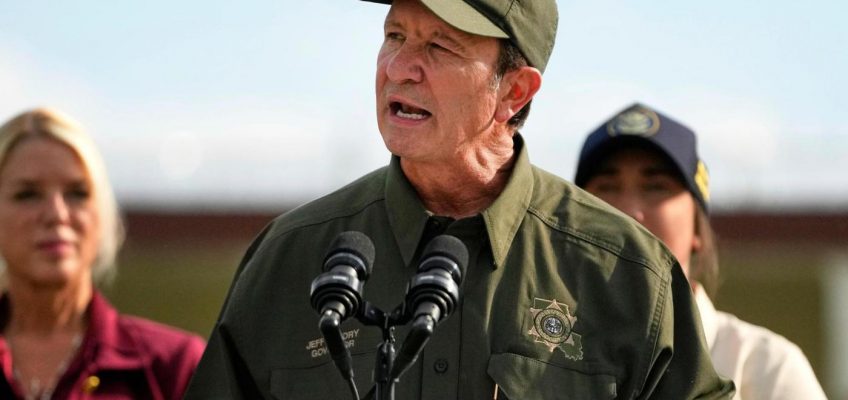By JIM MUSTIAN and SARA CLINE, Associated Press
BATON ROUGE, La. (AP) — The immigration detainees sent to a notorious Louisiana prison last month are being punished for crimes for which they have already served time, the American Civil Liberties Union said Monday in a lawsuit challenging the government’s decision to hold what it calls the “worst of the worst” there.
The lawsuit accuses President Donald Trump’s administration of selecting the former slave plantation known as Angola for its “uniquely horrifying history” and intentionally subjecting immigrant detainees to inhumane conditions — including foul water and lacking basic necessities — in violation of the Double Jeopardy clause, which protects people from being punished twice for the same crime.
The ACLU also alleges some immigrants detained at the newly opened facility should be released because the government failed to deport them within six months of a removal order. The lawsuit cites a 2001 Supreme Court ruling raised in several recent immigration cases, including that of the Palestinian activist Mahmoud Khalil, that says immigration detention should be “nonpunitive.”
“The anti-immigrant campaign under the guise of ‘Making America Safe Again’ does not remotely outweigh or justify indefinite detention in ‘America’s Bloodiest Prison’ without any of the rights afforded to criminal defendants,” ACLU attorneys argue in a petition reviewed by The Associated Press.
The AP sent requests for comment to the U.S. Department of Homeland Security, Immigration and Customs Enforcement and Louisiana Gov. Jeff Landry.
Related Articles
The first supermoon of the year is approaching. Here’s what to know
CDC stops recommending COVID-19 shots for all, leaves decision to patients
Ex-NFL QB Mark Sanchez faces felony in fight that authorities say was over a parking dispute
DOJ contradicts DeSantis: Some detainees at Everglades detention center likely never in removal proceedings
Venezuela denounces alleged ‘extremist’ plan to attack shuttered US Embassy complex
The lawsuit comes a month after state and federal authorities gathered at the sprawling Louisiana State Penitentiary to announce that the previously shuttered prison complex had been refurbished to house up to 400 immigrant detainees that officials said would include some of the most violent in ICE custody.
The complex had been described as “the dungeon” because it previously held inmates in solitary cells for more than 23 hours a day.
ICE repurposed the facility amid an ongoing legal battle over an immigration detention center in the Florida Everglades, and as Trump continues his large-scale attempt to remove millions of people suspected of entering the country illegally. The federal government has been racing to to expand its deportation infrastructure and, with state allies, has announced other new facilities, including in Indiana and Nebraska. ICE is seeking to detain 100,000 people under a $45 billion expansion Trump signed into law in July.
At Angola last month, Department of Homeland Security Secretary Kristi Noem told reporters the “legendary” maximum security prison, the largest in the nation, had been chosen to house a new ICE facility to encourage people in the U.S. illegally to self-deport. “This facility will hold the most dangerous of criminals,” she said.
Authorities said the immigration detainees would be isolated from Angola’s thousands of civil prisoners, many of whom are serving life sentences for violent offenses.
“I know you all in the media will attempt to have a field day with this facility, and you will try to find everything wrong with our operation in an effort to make those who broke the law in some of the most violent ways victims,” Landry, a Republican, said during a news conference last month.
“If you don’t think that they belong in somewhere like this, you’ve got a problem.”
The ACLU lawsuit says detainees at the facility already were “forced to go on hunger strike” to “demand basic necessities such as medical care, toilet paper, hygiene products and clean drinking water.” Detainees have described a long-neglected facility that was not yet prepared to house them, saying they are contending with mold, dust and ”black” water coming out of showers, court records show.
Federal and state officials have said those claims are part of a “false narrative” created by the media, and that the hunger strike only occurred after inaccurate reporting.
The lawsuit was filed in Baton Rouge federal court on behalf of Oscar Hernandez Amaya, a 34-year-old Honduran man who has been in ICE custody for two years. He was transferred to the facility last month from an ICE detention center in Pennsylvania.
Amaya fled Honduras two decades ago after refusing the violent MS-13 gang’s admonition “to torture and kill another human being,” the lawsuit alleges. The gang had recruited him at age 12, court documents say.
Amaya came to the United States, where he worked “without incident” until 2016. He was arrested that year and later convicted of attempted aggravated assault and sentenced to more than four years in prison. He was released on good-time credits after about two years and then transferred to ICE custody.
An immigration judge this year awarded Amaya “Convention Against Torture” protection from being returned to Honduras, the lawsuit says, but the U.S. government has failed to deport him to another country.
“The U.S. Supreme Court has been very clear that immigration detention cannot be used for punitive purposes,” Nora Ahmed, the ACLU of Louisiana’s legal director, told AP. “You cannot serve time for a crime in immigration detention.”
Mustian reported from New York




